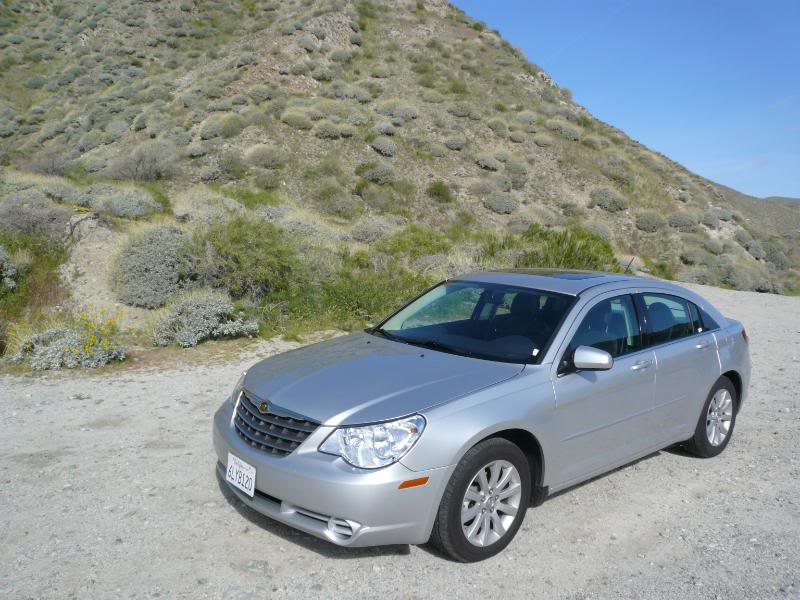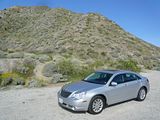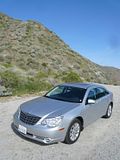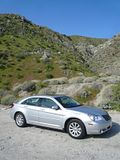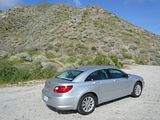Ignoring for the moment the fact that the best selling vehicles in North America remain pick-up trucks, the traditional sedan still outsells all the more creations such as minivans, SUVs, crossovers and whatever other terms the marketing brigade have coined to describe and categorise product, so it is still Very Important. For sure, the Toyota Camry and Honda Accord are the cars that battle for US sales honours, but look at the Top Twenty and you will find that a number of the mid-sized offerings from many major manufacturers feature in the best-seller lists, so this is clearly a critical area of the market not only in which to be represented, but also in which to have a credible and attractive product. Chrysler Corporation must have thought that this was what they were introducing in mid 2006 as a 2007 model year car when they presented their latest mid-sized family cars, the “JS” Chrysler Sebring and Dodge Avenger, hoping that they could do better than had proved possible with their outgoing Sebring and Dodge Stratus models. Press and public were less convinced, and the cars were instantly and roundly condemned in so many regards that they almost always came out bottom of any comparison tests. That was 2006, and many new competitors have been introduced since then, each generally representing a solid improvement on what went before, so it was with some interest that I took delivery of a Sebring for a couple of days, keen to see whether the car really was as mediocre as everyone else has opined.
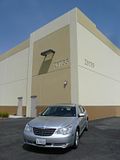
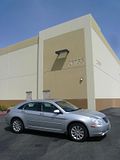
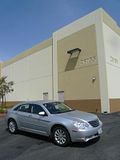
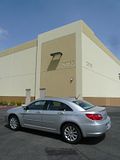
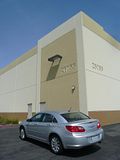 Whereas the previous generation Mopar mid-sizers shared all bar the detailed styling features such as grille and badges, for the 2006 cars, the Chrysler Sebring and Dodge Avenger adopted completely different external styling and interior presentation. Beauty is always in the eye of the proverbial beholder, but I don’t think I am expressing a minority view when I say that of the two, the Dodge is better looking than the Chrysler, and by some margin. Indeed, the Sebring’s first obstacle is its rather dumpy appearance, with a rounded roof line at odds with the chiselled edges of the rest of the bodywork. Substituting the fluted panel of the bonnet for a flat one, a change made for the 2010 model year cars was never really going to address the full problem, as it is rather more fundamental than that. Somehow the details, many of which had been previewed on Chrysler Concept cars in the first half of the decade just do not gel together at all on this car.
Whereas the previous generation Mopar mid-sizers shared all bar the detailed styling features such as grille and badges, for the 2006 cars, the Chrysler Sebring and Dodge Avenger adopted completely different external styling and interior presentation. Beauty is always in the eye of the proverbial beholder, but I don’t think I am expressing a minority view when I say that of the two, the Dodge is better looking than the Chrysler, and by some margin. Indeed, the Sebring’s first obstacle is its rather dumpy appearance, with a rounded roof line at odds with the chiselled edges of the rest of the bodywork. Substituting the fluted panel of the bonnet for a flat one, a change made for the 2010 model year cars was never really going to address the full problem, as it is rather more fundamental than that. Somehow the details, many of which had been previewed on Chrysler Concept cars in the first half of the decade just do not gel together at all on this car.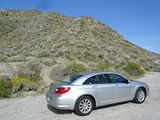
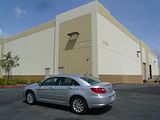 Still, looks are only one element of the merit of a car, and if it drives well, they can be, well, if not forgiven, at least overlooked to some extent. So, does the Sebring drive well? Expectations were not high in this regard, either, as the driving dynamics are another area where the Sebring has taken a pasting from the press. Particular model for their condemnation is the entry level 4 cylinder 2.4 litre car, so I was relieved to find that my test car was a V6, as the engine in this version is widely viewed as far less odious. Spotting the Limited badge on the back, I did hope that perhaps I had a top spec 3.5 litre car, but a quick glance under the bonnet confirmed that in fact I was driving the middle engine of the three on offer, the 2.7 litre, which develops 186bhp. Although this is not a vast increase on the quoted 173bhp of the 4 cylinder car, the extra smoothness and refinement makes this an option well worth considering, if not actually mandating. Push hard and even this engine can get quite raucous, though when cruising at a steadier speed, it is decently smooth and refined.Whilst not fast, nor is it embarrassingly slow, and it is probably pretty class competitive in this regard. As a rental car, the test vehicle came with an automatic gearbox, and most of the time, the four speed ‘box provided almost imperceptibly smooth gearchanges, but there were a few occasions, generally when travelling quite slowly, such as in traffic, when the gearbox could jerk a bit, as it struggled to work out which was the most appropriate gear. In keeping with the general simplicity of the Sebring, there is only the one mode for the transmission, and there are no column mounted paddles to use.Economy was not brilliant, working out at 20 mpg (US). The most serious dynamic shortcoming concerns the steering. Not only is it very light, indeed too light most of the time, but it is a set up (sadly becoming not so uncommon) which makes one wonder if there is a bowl of soup connecting the movements from the steering wheel to the road wheels. This lack of precision has a direct consequence on the handling, as whilst it is so difficult to get any sensation what the steered wheels are doing, you are not encouraged to head into a corner at anything other than “gently” speeds. Even then, I found it surprisingly difficult to corner tidily or to keep to the intended line. Despite these woes, the Sebring rides quite well, absorbing the worst of the poor surfaces that abound on the streets of the greater Los Angeles area. The brakes seemed OK, though you had to push on the pedal perhaps a little harder than you might expect. There is a pull-up handbrake between the seats. Another weak area is visibility. I found out – in one slightly scary Freeway moment – that there is a huge blind spot on the driver’s side, a problem exacerbated no doubt by the rather small door mirrors. The slope of the rear screen means that rear visibility is also not particularly good, making reversing and parking a little challenging.
Still, looks are only one element of the merit of a car, and if it drives well, they can be, well, if not forgiven, at least overlooked to some extent. So, does the Sebring drive well? Expectations were not high in this regard, either, as the driving dynamics are another area where the Sebring has taken a pasting from the press. Particular model for their condemnation is the entry level 4 cylinder 2.4 litre car, so I was relieved to find that my test car was a V6, as the engine in this version is widely viewed as far less odious. Spotting the Limited badge on the back, I did hope that perhaps I had a top spec 3.5 litre car, but a quick glance under the bonnet confirmed that in fact I was driving the middle engine of the three on offer, the 2.7 litre, which develops 186bhp. Although this is not a vast increase on the quoted 173bhp of the 4 cylinder car, the extra smoothness and refinement makes this an option well worth considering, if not actually mandating. Push hard and even this engine can get quite raucous, though when cruising at a steadier speed, it is decently smooth and refined.Whilst not fast, nor is it embarrassingly slow, and it is probably pretty class competitive in this regard. As a rental car, the test vehicle came with an automatic gearbox, and most of the time, the four speed ‘box provided almost imperceptibly smooth gearchanges, but there were a few occasions, generally when travelling quite slowly, such as in traffic, when the gearbox could jerk a bit, as it struggled to work out which was the most appropriate gear. In keeping with the general simplicity of the Sebring, there is only the one mode for the transmission, and there are no column mounted paddles to use.Economy was not brilliant, working out at 20 mpg (US). The most serious dynamic shortcoming concerns the steering. Not only is it very light, indeed too light most of the time, but it is a set up (sadly becoming not so uncommon) which makes one wonder if there is a bowl of soup connecting the movements from the steering wheel to the road wheels. This lack of precision has a direct consequence on the handling, as whilst it is so difficult to get any sensation what the steered wheels are doing, you are not encouraged to head into a corner at anything other than “gently” speeds. Even then, I found it surprisingly difficult to corner tidily or to keep to the intended line. Despite these woes, the Sebring rides quite well, absorbing the worst of the poor surfaces that abound on the streets of the greater Los Angeles area. The brakes seemed OK, though you had to push on the pedal perhaps a little harder than you might expect. There is a pull-up handbrake between the seats. Another weak area is visibility. I found out – in one slightly scary Freeway moment – that there is a huge blind spot on the driver’s side, a problem exacerbated no doubt by the rather small door mirrors. The slope of the rear screen means that rear visibility is also not particularly good, making reversing and parking a little challenging.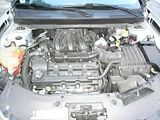
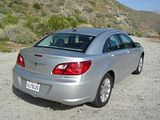
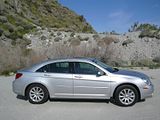 All recent Chrysler Group vehicles have been soundly condemned for their low rent interiors, and I am sad to have to report that the Sebring really is a case in point. There is a jumbled mixture of low quality plastics of various different types, some of which are harder and nastier than others, and not all of which fit together that well. In an effort to provide some visual lift, there are generous swathes of plastic-minium, and some very odd fake wood that looks almost like polished amber, with a quasi-transparent effect. The combination of some poor quality leather and this “wood” on the steering wheel is decidedly unfortunate, as opposed to “classy”, which is probably not quite what the designers had in mind. That said, the dashboard is actually quite clear and simple in basic design, and everything is easy to use. There are three dials, individually deeply dished, with more of the plastic aluminium rings round the top, which contain the speedo, rev counter, and the left hand one with smaller gauges for fuel level and water temperature. There is a trip meter function, which can also be used to show the ambient temperature, though pressing the small button set between two of the dials is rather fiddly and you have to reach around the steering wheel to do so. There are two column stalks, with twist operated ends on the left hand one for the lights and on the right for the wipers. With the latter whilst you do have to twist through all the intermittent settings to get to continuous wipe, there is at least a flick wipe by holding the stalk down. The centre of the dash contains the easy to use audio and climate control functions, and that is about it. There is nothing fancy or complicated about this car.
All recent Chrysler Group vehicles have been soundly condemned for their low rent interiors, and I am sad to have to report that the Sebring really is a case in point. There is a jumbled mixture of low quality plastics of various different types, some of which are harder and nastier than others, and not all of which fit together that well. In an effort to provide some visual lift, there are generous swathes of plastic-minium, and some very odd fake wood that looks almost like polished amber, with a quasi-transparent effect. The combination of some poor quality leather and this “wood” on the steering wheel is decidedly unfortunate, as opposed to “classy”, which is probably not quite what the designers had in mind. That said, the dashboard is actually quite clear and simple in basic design, and everything is easy to use. There are three dials, individually deeply dished, with more of the plastic aluminium rings round the top, which contain the speedo, rev counter, and the left hand one with smaller gauges for fuel level and water temperature. There is a trip meter function, which can also be used to show the ambient temperature, though pressing the small button set between two of the dials is rather fiddly and you have to reach around the steering wheel to do so. There are two column stalks, with twist operated ends on the left hand one for the lights and on the right for the wipers. With the latter whilst you do have to twist through all the intermittent settings to get to continuous wipe, there is at least a flick wipe by holding the stalk down. The centre of the dash contains the easy to use audio and climate control functions, and that is about it. There is nothing fancy or complicated about this car.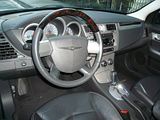
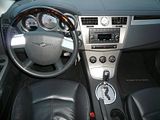
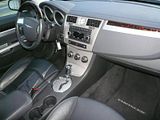 The seats of the test car were leather covered. This was the sort of leather that almost looks like the dreaded vinyl of yore, but that was not the worst problem. Far more seriously, despite the availability of electric adjustment for fore/aft, up/down and backrest, the seat simply was not very comfortable. The problem seemed to be that the seat was rather flat and devoid of shape. It was definitely an issue of the seat itself, as I was able to get the correct driving position with no problem, and indeed found that – quite unusually – the seat would actually go lower than I needed. Even allowing for the loss of clearance from the sun-roof this meant that there was ample head room in the car.
The seats of the test car were leather covered. This was the sort of leather that almost looks like the dreaded vinyl of yore, but that was not the worst problem. Far more seriously, despite the availability of electric adjustment for fore/aft, up/down and backrest, the seat simply was not very comfortable. The problem seemed to be that the seat was rather flat and devoid of shape. It was definitely an issue of the seat itself, as I was able to get the correct driving position with no problem, and indeed found that – quite unusually – the seat would actually go lower than I needed. Even allowing for the loss of clearance from the sun-roof this meant that there was ample head room in the car.
Sebring Sedan is offered in two trim levels: Touring and Limited. The test car was the plusher of these, but was far from what you what you could call a luxury level of equipment. The glass sun roof added light to the cabin, and I appreciated the Satellite radio. On a wet and grey day, there was little for the climate control to do. When I looked up to see the differences between the spec levels, it turned out that the upgrade to Limited brings the leather seats, an 8-way power adjustable driver’s seat, automatic headlights, heated seats and mirrors, an upgraded audio system and 17″ wheels on alloys. The cost difference is $2000, which seems quite a lot.
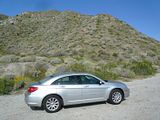
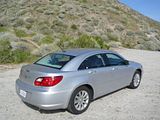 Car rental companies tend to categorise the more “everyday” vehicles simply by size. Recent years have seen more than a few vehicles suddenly promoted to the class above the one that they used to occupy or where you expect them to be. With the current Toyota Corolla and US Honda Civic now deemed to be “mid-sized” cars, perhaps I should not be too surprised to find that the Sebring is once again a class above these vehicles, and now counts as a “standard”. That means that you might expect to find that it has more room for people and luggage than you would find in the “mid-sized” cars, such as the Corolla, Sentra, Civic and Jetta. You might hope for this, but you would probably be disappointed by the reality. There is far more room in the Sebring sedan than there is in the Convertible, and three adults could fit in the back. Leg room will not be an undue problem, unless the front seat passenger has the seat right back as far as it will go, and there is decent head room, but shoulder width might be a bit tight. There is not much space for the occupants’ odds and ends, and this lacuna will also bedevil those sitting in the front seats, who merely have access to a meagre glovebox, some rather short door pockets and a shallow cubby under the centre armrest. The boot is not all that large, either.
Car rental companies tend to categorise the more “everyday” vehicles simply by size. Recent years have seen more than a few vehicles suddenly promoted to the class above the one that they used to occupy or where you expect them to be. With the current Toyota Corolla and US Honda Civic now deemed to be “mid-sized” cars, perhaps I should not be too surprised to find that the Sebring is once again a class above these vehicles, and now counts as a “standard”. That means that you might expect to find that it has more room for people and luggage than you would find in the “mid-sized” cars, such as the Corolla, Sentra, Civic and Jetta. You might hope for this, but you would probably be disappointed by the reality. There is far more room in the Sebring sedan than there is in the Convertible, and three adults could fit in the back. Leg room will not be an undue problem, unless the front seat passenger has the seat right back as far as it will go, and there is decent head room, but shoulder width might be a bit tight. There is not much space for the occupants’ odds and ends, and this lacuna will also bedevil those sitting in the front seats, who merely have access to a meagre glovebox, some rather short door pockets and a shallow cubby under the centre armrest. The boot is not all that large, either.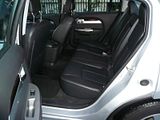
 In some ways, it is almost superfluous to present a conclusion on the Sebring. Ever since its launch in 2006, it has been largely condemned by almost all who have come across it, and new parent company, Fiat, must have been in absolutely no doubt that they could not simply leave the car until the proposed replacement date in 2013/14, which is why a fairly drastic set of revisions made their debut for the 2011 model year. There was even sufficient concern that the name “Sebring” could be “damaged goods” in too many peoples’ minds, so the facelifted car comes with a new name, as the Chrysler 200. Press reviews of this car suggest that, whilst it is not class-leading, it is far more competitive than you might expect. I look forward to finding out for myself in due course. As to the Sebring, well, I am afraid it really is as mediocre as everyone has long said. Whilst nothing about it is actually bad, it is simply beaten on just about every measure by just about every competitor. In its homeland, I can understand that attractive pricing and (extreme) brand loyalty may have helped its cause,though sales volume in 2009 was less than a third of what it had been in 2007. In Europe, where the car was saddled with not just a very limited dealer network, and some rough and unrefined diesel engines, what on earth possessed anyone at all buy one, (and a surprising number of people did!), I really cannot understand.
In some ways, it is almost superfluous to present a conclusion on the Sebring. Ever since its launch in 2006, it has been largely condemned by almost all who have come across it, and new parent company, Fiat, must have been in absolutely no doubt that they could not simply leave the car until the proposed replacement date in 2013/14, which is why a fairly drastic set of revisions made their debut for the 2011 model year. There was even sufficient concern that the name “Sebring” could be “damaged goods” in too many peoples’ minds, so the facelifted car comes with a new name, as the Chrysler 200. Press reviews of this car suggest that, whilst it is not class-leading, it is far more competitive than you might expect. I look forward to finding out for myself in due course. As to the Sebring, well, I am afraid it really is as mediocre as everyone has long said. Whilst nothing about it is actually bad, it is simply beaten on just about every measure by just about every competitor. In its homeland, I can understand that attractive pricing and (extreme) brand loyalty may have helped its cause,though sales volume in 2009 was less than a third of what it had been in 2007. In Europe, where the car was saddled with not just a very limited dealer network, and some rough and unrefined diesel engines, what on earth possessed anyone at all buy one, (and a surprising number of people did!), I really cannot understand.2011-04-06 06:20:30



















